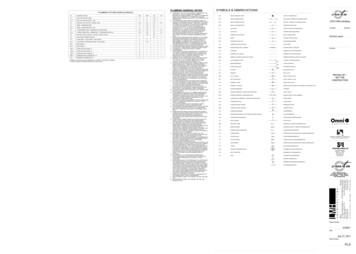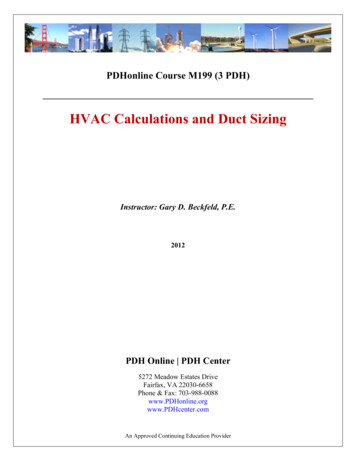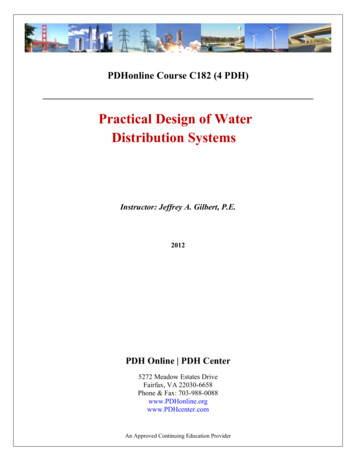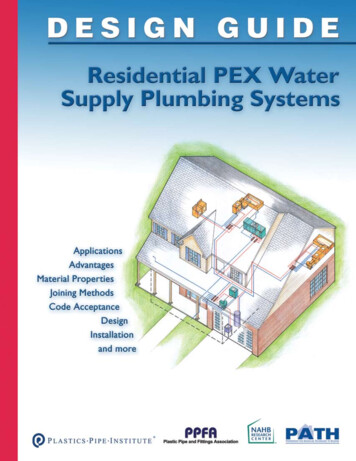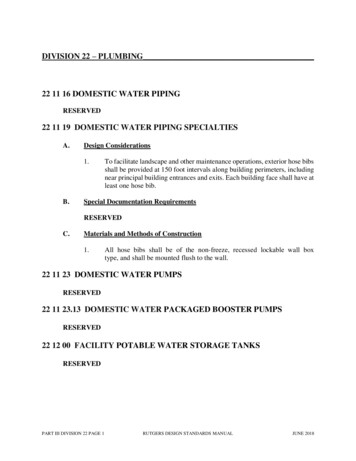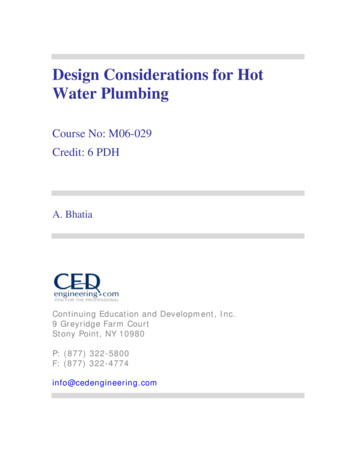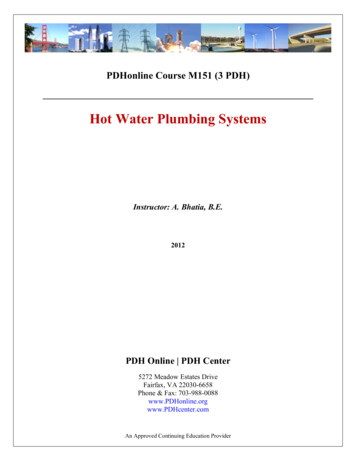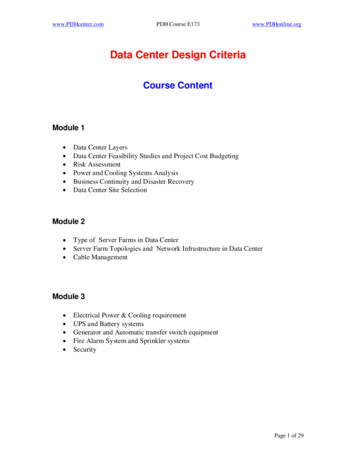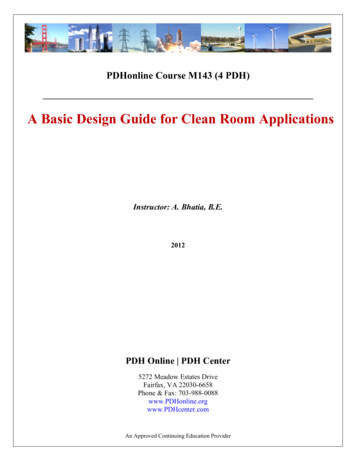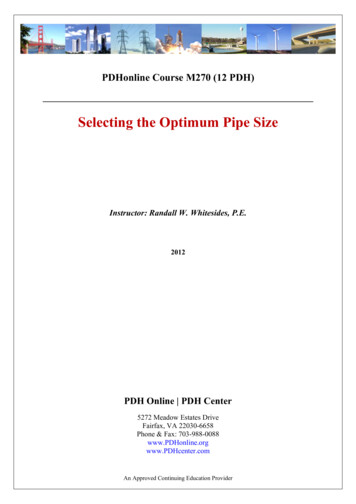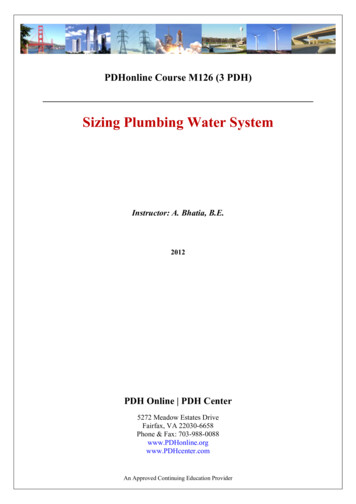
Transcription
PDHonline Course M126 (3 PDH)Sizing Plumbing Water SystemInstructor: A. Bhatia, B.E.2012PDH Online PDH Center5272 Meadow Estates DriveFairfax, VA 22030-6658Phone & Fax: 703-988-0088www.PDHonline.orgwww.PDHcenter.comAn Approved Continuing Education Provider
www.PDHcenter.comPDH Course M126www.PDHonline.orgSizing Plumbing Water SystemsA. Bhatia, B.E.Course ContentPART I -ESTIMATING WATER DEMANDSA fundamental consideration in the sizing of a plumbing water system or its componentsis an estimate of the amount of water expected to be used by the customers.Estimating demand depends on the water usage patterns and is usually unique for aparticular system. For instance, a difference can exist for a residential and a nonresidential system. A water usage pattern may also be unique because of theindividuality of consumers on the system and their expectations to use water wheneverand however they wish.Water demand estimation is complex and involves consideration of a number of factors:1. Climatic influences (evaporation, vapor transpiration, temperature, precipitation,winds, etc.); Climate has a significant impact on water use. For instance, in areaswhere freezing temperatures are prevalent, water use should be closelyevaluated. Some systems may see higher demands as users allow faucets torun to prevent freezing.2. Socioeconomic influences (property values, economic status, residentialdensities); Demographics change with the nature of a development. Populationdensities are different for single family and multi-family residences; for housingprovided for families and housing provided for singles or senior citizens/retirees;and for individual lots and mobile home park type developments.3. Property lots; Housing sizes are usually directly linked to the income levels of theresidents. Middle-income residents typically occupy 1,500 to 3,000 square foothomes with moderate sized lawns. Higher income residents occupy homeslarger than 3,000 square feet. With respect to water use, the greatest impact ofincome level is probably the extent of landscaping. The major factor in water userelated to larger lot sizes is in the irrigable area, such as lawns, gardens, andother agricultural uses.4. Recreational or seasonal uses; Water use and demand at public places, such asamusement parks, vary and can be different. Recreational areas usuallyexperience peak demands during summer holiday weekends such as MemorialDay, Independence Day, and Labor Day. A. BhatiaPage 2 of 35
www.PDHcenter.comPDH Course M126www.PDHonline.org5. Extent of metering or pricing schedules; Water pricing structure may vary place toplace. Some systems may use a water meter that tends to price on actual use;others may have ‘flat rates’ fixed on property size.6. Historic water log sheets; Places like airports, hotels, hospitals and publicbuildings see more or less consistent overall demand. The only design variableinvolved for the facility is the volume of traffic.7. Land use; The purpose of a facility should be assessed. Commercial, industrialand public facility demands are much different from residential demand. Wateruse associated with the services of cleaning, landscaping, and farming need tobe assessed carefully.8. Conservation practices; Areas that have acute or scarce water resources resortto mandatory conservation measures. Mandatory conservation practices include,but are not limited to, alternate day watering schedules, installation of low wateruse fixtures, water closet tank displacement devices, leak detection, rainwaterharvesting, and use of treated effluent water for landscaping. Unaccounted waterdemand reduction programs also exist. Community covenants, bylaws or localordinances may exist to support water conservation practices. It is very importantto determine if water use restrictions are enforceable.Why Plumbing Codes?It is nearly impossible to predict the consumer mind-set or socioeconomic ethics on wateruse. There is usually insufficient data to account for all the factors that may influence thewater demands of a particular water system.Defined design criteria are laid out in the ASHRAE guide and the Uniform Plumbing Code(UPC). Both criteria focus on the use of probability theory with a safety factor tocompensate for unknown variables. Required flow rates are defined based on a “FixtureCount” method that is determined after appropriate research and analysis of controllingvariables. Among a host of other factors, these variables are fixture types, people usefactors for structure types, and people socioeconomic factors.There is no substitute for reliable and accurate meter records of water usage forestimating future demand. An historic data approach allows a designer to use meteredwater use data from an existing facility to estimate the demand of a new system.Model Plumbing CodesThe model universal plumbing codes list minimum requirements for potable watersystems based on probability theory. A. BhatiaPage 3 of 35
www.PDHcenter.comPDH Course M126www.PDHonline.orgThe five model plumbing code agencies in the United Sates are:1. Uniform Plumbing Code (UPC); adopted mainly in the western U.S.2. Standard Plumbing Code (SPC); adopted mainly in the southern U.S.3. BOCA Plumbing Code (BOCA); adopted mainly in the eastern U.S.4. International Plumbing Code (IPC).5. CABO Plumbing Code (CABO); exclusively for residential construction.Salient features of these codes are: The IPC is relatively new code originating in 1995 as a joint effort of the threemajor model code groups (UPC, SPC and BOCA). The CABO, also derived from these three major codes, is designedexclusively for plumbing of one and two family residential dwellings. The provisions of the above codes are essentially consistent, but containsomewhat different requirements to address factors that are unique to localconditions. For instance, the UPC contains information that considers theearthquake prone western U.S. region. In many cases, a local municipality orjurisdictional authority will add addenda to deal with a specific situation of anarea. All of the model plumbing codes require water supply systems to be designedto deliver a specified flow rate (gallons per minute) within certain pressurelimits. Each code lists procedures for calculating design flow rates that are directlyrelated to the number of plumbing fixtures within the building. (Check UPC1997, Appendix A; SPC-1997, Appendix F; IPC-1995, Appendix E; CABO1995, Sect 3409). The model codes require a minimum inlet nominal diameter of water supplypiping to be at least ¾ inch. (Check UPC-1997, Sect. 610.8; SPC-1997, Sect.608.2; IPC-1995, Sect. 604.1; CABO- 1995, Sect 3403.4)Estimating Potable Water DemandTheoretically all plumbing system (pipes) should be sized for maximum flow rate that iscapable of serving the fixtures simultaneously. In practice the chances of their simultaneoususe are remote and the plumbing (piping) design criteria may be relaxed to some degree.Plumbing water distribution systems shall be designed on the idea of the most probable peakdemand loading, which reflects the worst-case scenario for a system. A. BhatiaPage 4 of 35
www.PDHcenter.comPDH Course M126www.PDHonline.orgThere are two methods that have been proposed to aid in the design of plumbing watersystems. Currently, the plumbing industry uses Hunter’s method for approximating peakdemand loadings on a building’s water distribution system. This method was developed in the1940’s and presented in the National Bureau of Standards published report BMS 65,“Methods of Estimating Loads in Plumbing Systems”. It is still the most widely used procedureand forms the basis for model plumbing codes (e.g. The International Plumbing Code, TheUniform Plumbing Code and ASHRAE guide).Another method, which is not cited in any major U.S. plumbing codes, has been developed bythe American Water Works Association (AWWA). The “fixture value method” was introducedin 1975 and presented in AWWA’s M22 Manual. This method is an empirical approach basedon data obtained from water meter data loggers. This method is not recommended for sizingthe plumbing water branches, laterals or risers and is primarily used for sizing for waterservice lines only. Both procedures are separately discussed in the following paragraphs.Before we proceed further let’s define few important terms:1. Fixture - A fixture is any device for the distribution and use of water in a building.Example: shower, urinal, fountain, shower, sink, water faucet, tap, hose bibs, hydrantetc.2. Maximum flow – Maximum flow or maximum possible flow is the flow that will occurif the outlets on all fixtures are opened simultaneously. Since most plumbing fixturesare used intermittently and the time in operation is relatively small, it is not necessaryto design for the maximum possible load. Maximum flow is therefore of no realinterest to the designer.3. Average flow – Average flow is flow likely to occur in the piping under normalconditions. Average flow is also of little concern to the designer, for if a system weredesigned to meet this criterion, it would not satisfy the conditions under peak flow.Average flow is typically used for determining the storage tank volume factoring thehours of storage required.4. Maximum probable flow – Maximum probable flow is the flow that will occur in thepiping under peak conditions. It is NOT the total combined flow with all fixtures wideopen at the same time, but is proportional to the number of fixtures that may beexpected to be in use simultaneously. It is also called peak demand or maximumexpected flow. The plumbing water system is designed on maximum probable flow.5. Continuous demand - Some outlets impose continuous demand on the system forexample; hose bibs, lawn irrigation, air-conditioning makeup, water cooling, andsimilar flow requirements are considered to be continuous demands. They occur overan extended period of time.6. Intermittent demand – Plumbing fixtures draw water for relatively short periods oftime are considered an intermittent demand. The examples include bathroom fixtures, A. BhatiaPage 5 of 35
www.PDHcenter.comPDH Course M126www.PDHonline.orgkitchen sinks, Laundry trays and washing machines. Each fixture has its own singularloading effect on the system, which is determined by the rate of water supplyrequired, the duration of each use, and the frequency of use.What is a Fixture Units Count?The fixture unit concept is a method of calculating maximum probable water demand withinlarge buildings based on theory of probability. The method is based on assigning a fixture unit(f/u) value to each type of fixture based on its rate of water consumption, on the length of timeit is normally in use and on the average period between successive uses. All the abovefactors, together, determine the rate of flow with a plumbing pipe.Hunter’s Method of Estimating Loads in Plumbing SystemsHunter’s method of estimating load in plumbing systems is based on assigning a fixture unitweight (f/u) to the plumbing fixtures and then converting these to equivalent gallons perminute, based on the theory of probability of usage.Hunter observed that all fixtures are not used simultaneously. The durations of use aredifferent and times between uses are different. He estimated the flowrates through variousfixtures by capturing average flow and the time span of single operation for different fixtures.For example, a flush valve was considered to operate over a 9 second period providing anaverage volume of 4 gallons. This yields a design flow of 27gpm ----- [(4/9)*(60) 26.6gpm].Similarly for flush tanks, he found that it takes approx a minute (60seconds) to deliver 4gallons. This yields a design flow of 4gpm----- [(4/60)*(60) 4gpm].Hunter also found an average time between successive usages (frequency of use) fromrecords collected in hotels and apartment houses during the periods of heaviest usage. Thiswas important to evaluate “how many fixtures could be operated simultaneously” since it isless likely that all the fixtures in the building will be operated simultaneously. Consider abuilding with 20 flush valves and 20 flush tanks. Hunter applied probability theory todetermine how many of these 20 fixtures each will be operated at any given instant with thecondition that this occurrence won’t exceed more than one percent of the time. He observedthat the probability of using more than 3 flush valves and 8 flush tanks simultaneously is lessthan 1%.Therefore, the peak design flow is worked out to be 3 * 27 81gpm for flush valve and 8 * 4 32gpm for flush tanks, and,The pipe capacity shall be 3 *27 8 *4 113gpm. A. BhatiaPage 6 of 35
www.PDHcenter.comPDH Course M126www.PDHonline.orgHunter realized that the probability theory could be greatly simplified, if a common fixtureloading unit is applied to the plumbing fixtures. Hunter arbitrarily assigned a singular basefixture unit weight of 10 to the flush valve and other fixture types were then given a fixture unitweight in terms of their comparative flow rate and time- usage factor in relation to the basefixture (flush valve). He obtained a weight of 5 for flush tank and 4 for bathtub whichcorresponds to demand ratio of 1:2:2.5 between the three common fixture types (flush valves,flush tanks, and bathtubs, respectively). All fixtures are thus converted, in essence, to onefixture type i.e. each unit of flush valve corresponding to 10 fixture units; each unit of flushtanks has 5 fixture units and each unit of bathtub has 4 fixture units.Table -1 lists the demand weights in “fixture units” as determined by the National Bureau ofStandards. It is used in conjunction with Figure -1 or Table-2 in determining the expectednormal peak flow for any number or combination of fixtures.TABLE – 1Demand weights of plumbing items in Fixture UnitsFixture or GroupOccupancyCold Water(CW) onlyHot Water(HW) onlyWater Closet (Flush Valve)Water Closet (Flush Tank)Pedestal Urinal (Flush Valve)Stall
The five model plumbing code agencies in the United Sates are: 1. Uniform Plumbing Code (UPC); adopted mainly in the western U.S. 2. Standard Plumbing Code (SPC); adopted mainly in the southern U.S. 3. BOCA Plumbing Code (BOCA); adopted mainly in the eastern U.S. 4. International Plumbing Code (IPC). 5. CABO Plumbing Code (CABO); exclusively for residential construction.
